Buttercup creeping: description and application. Planting and care in the open field.
Buttercup is a tender herb with amazingly beautiful flowers. Particularly interesting garden forms with large spherical heads. The plant belongs to the Buttercup family. The genus is represented not only by ornamental species, but also by weeds with caustic and poisonous juice. Buttercups are common in the temperate and cold climate of the entire Northern Hemisphere. They live in open meadows and fresh water. The scientific name of the buttercup - “ranunculus” - comes from the word “frog”. It is given for the ability to grow where amphibians live.
What a buttercup looks like
Buttercup is a perennial or annual with direct branched shoots up to 20-100 cm in height. It has a fibrous root system, on the processes of which spidery, spider-like tubers are formed. On the thickened ribbed stem is located the next foliage with whole toothed or dissected plates. It has a bluish-green or dark green color. The leaves do not differ in large sizes, usually the length does not exceed 6 cm.
In June-July, beautiful flowers bloom on the tops of the stems. They can be simple or terry, like flowers of roses and peonies. The number of flower elements is a multiple of 5 (less often 3). The diameter of the corolla depends on the variety and can be 2-10 cm. The color of the flowers is very diverse (monophonic or variegated): bright salmon, purple, yellow, orange, cream, white. In the center there are many short stamens and pistils. The flowering period lasts about a month. In cutting the flowers will stand in a vase for at least a week.
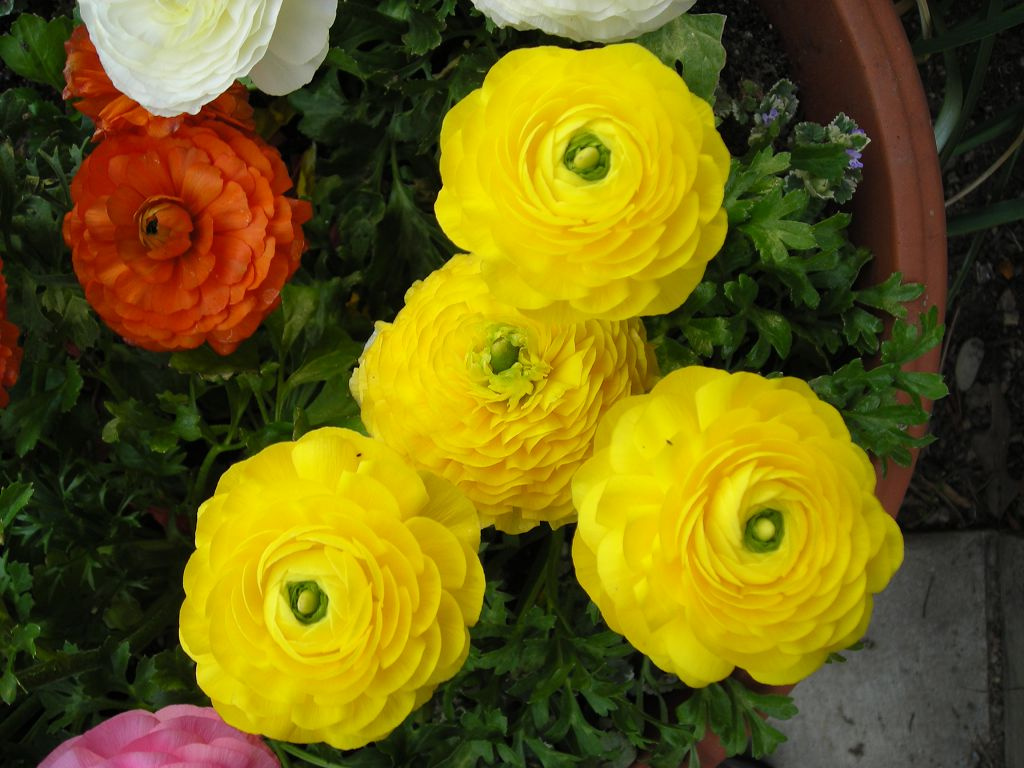

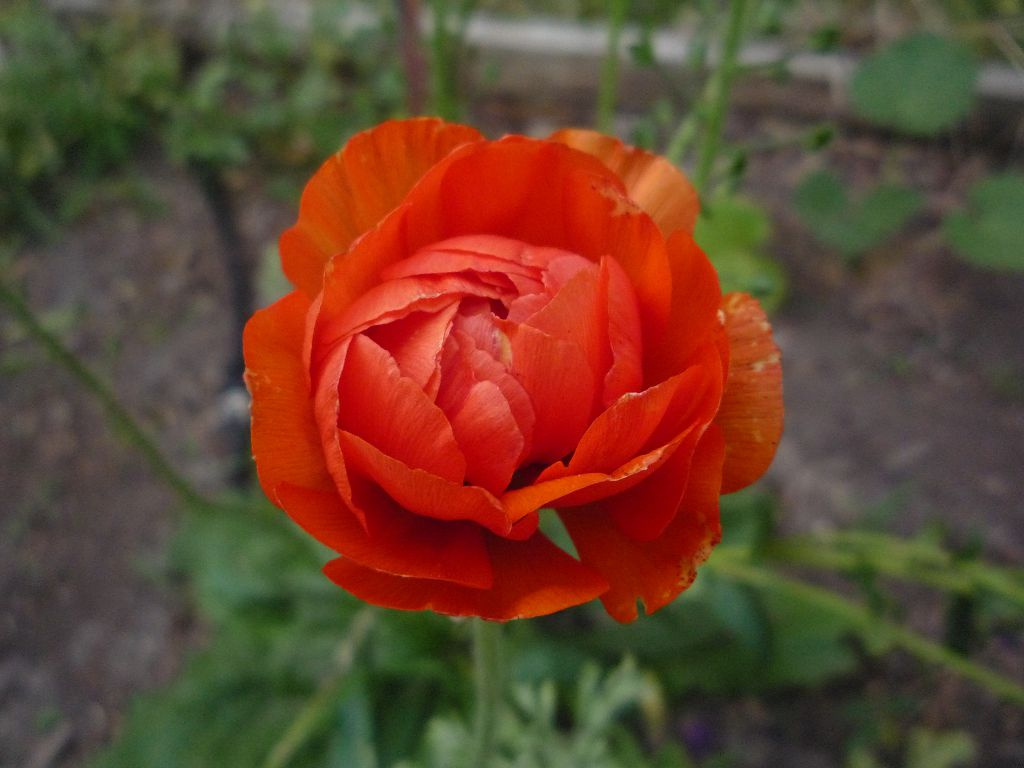
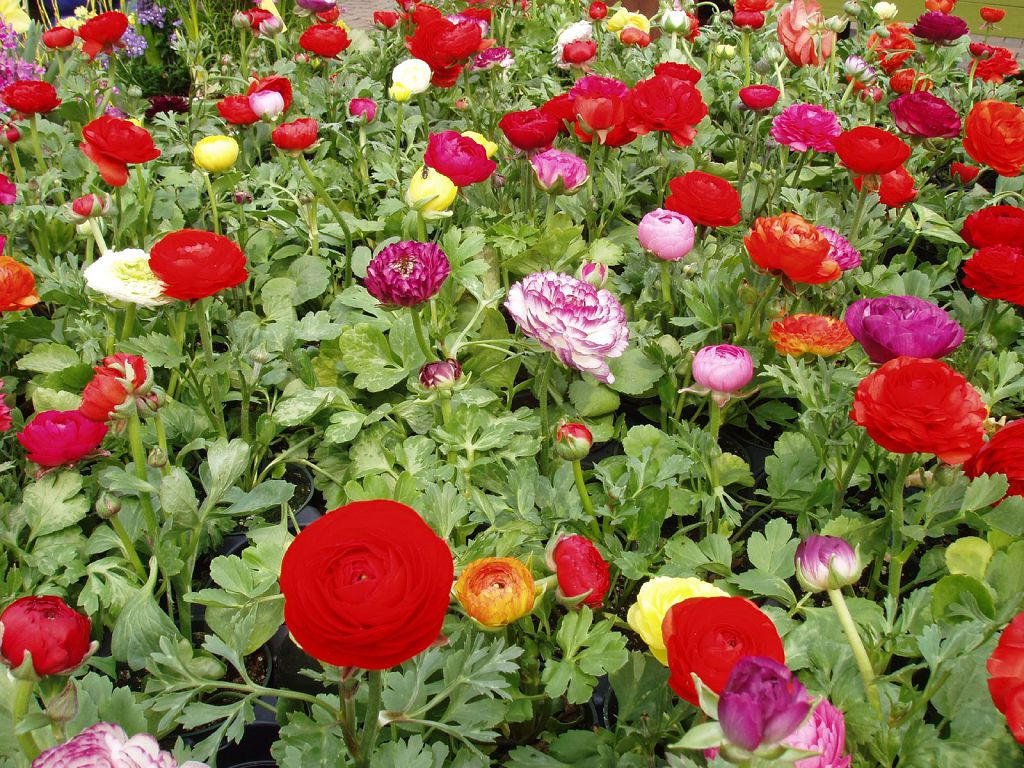

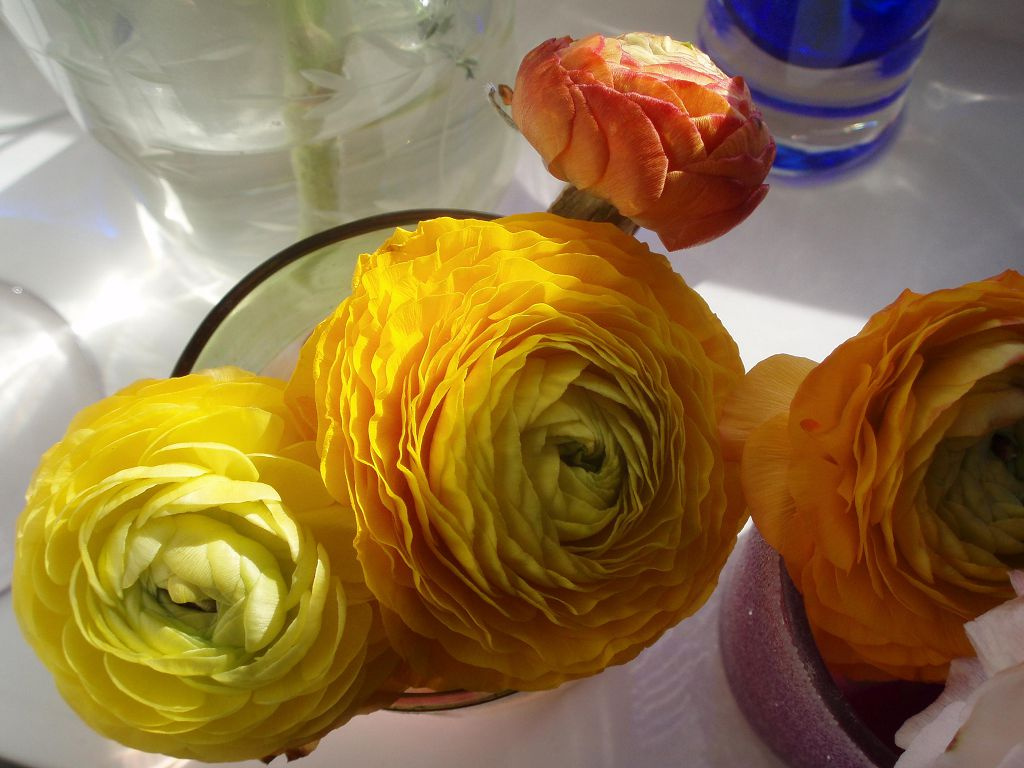
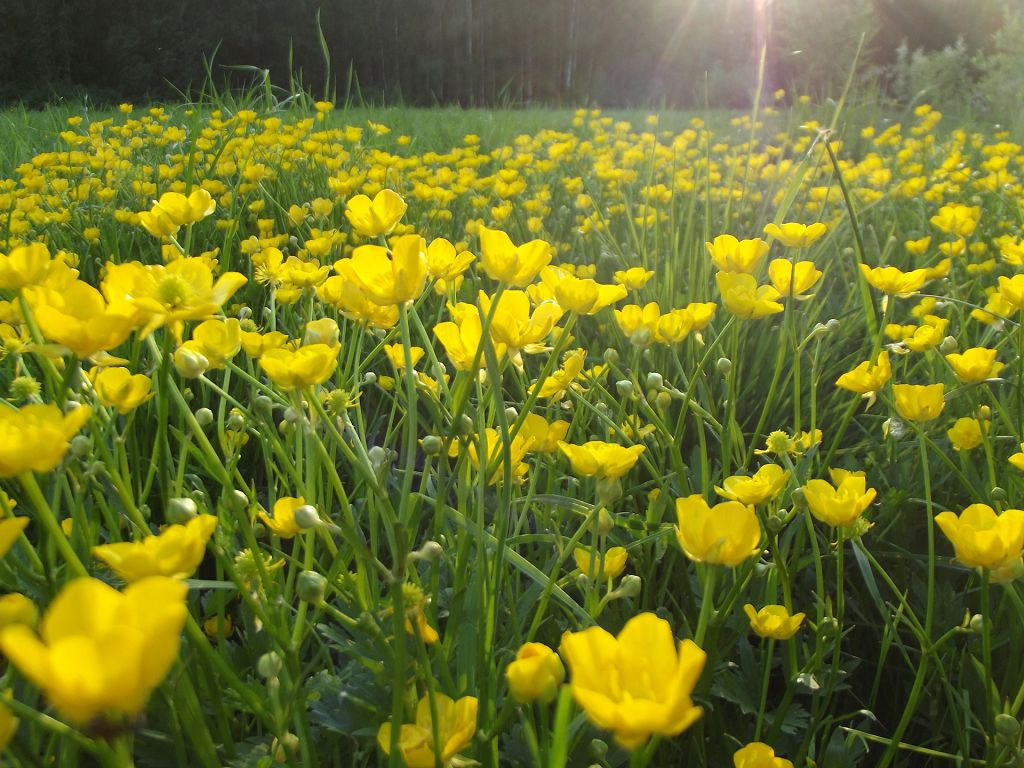
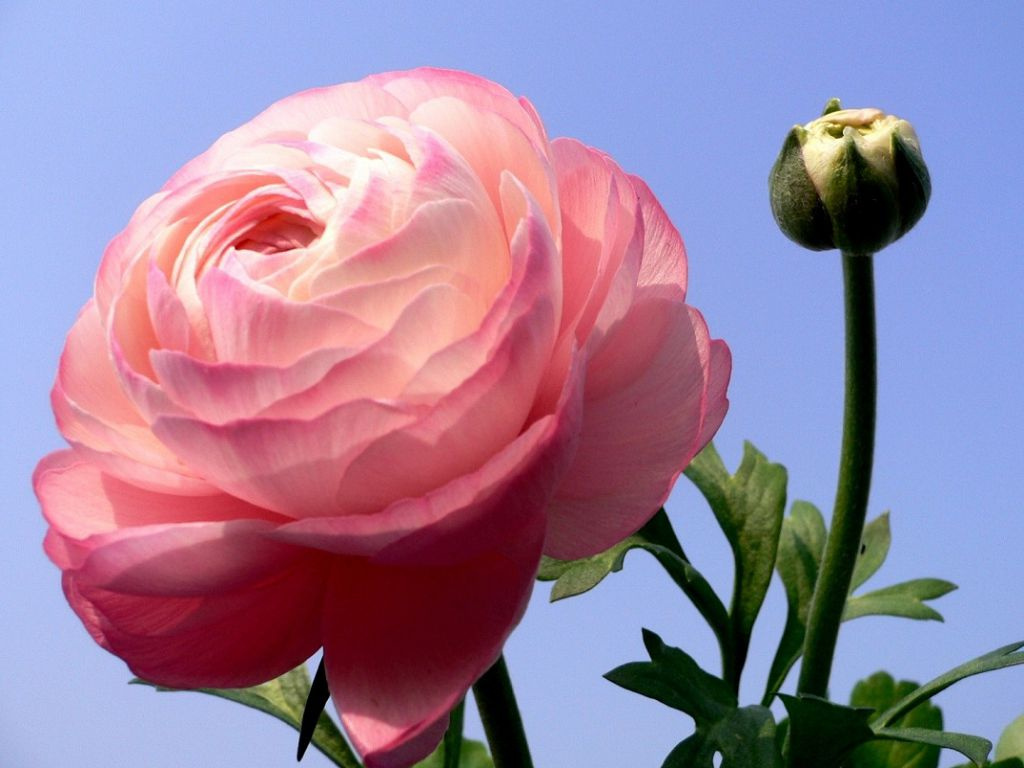
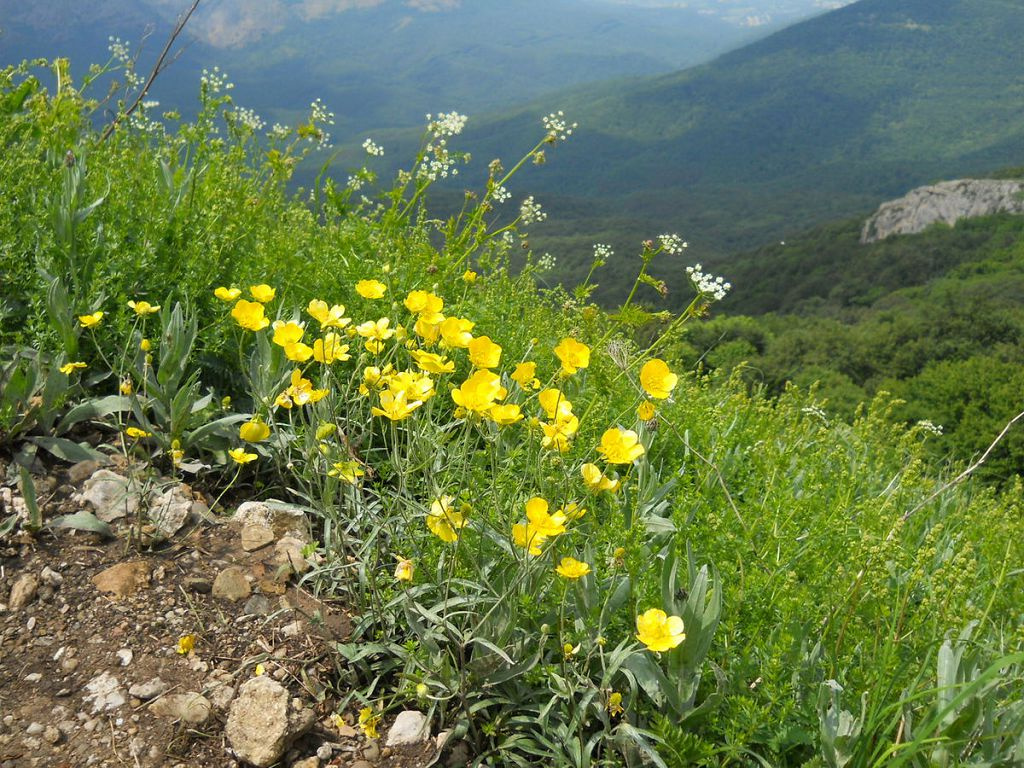


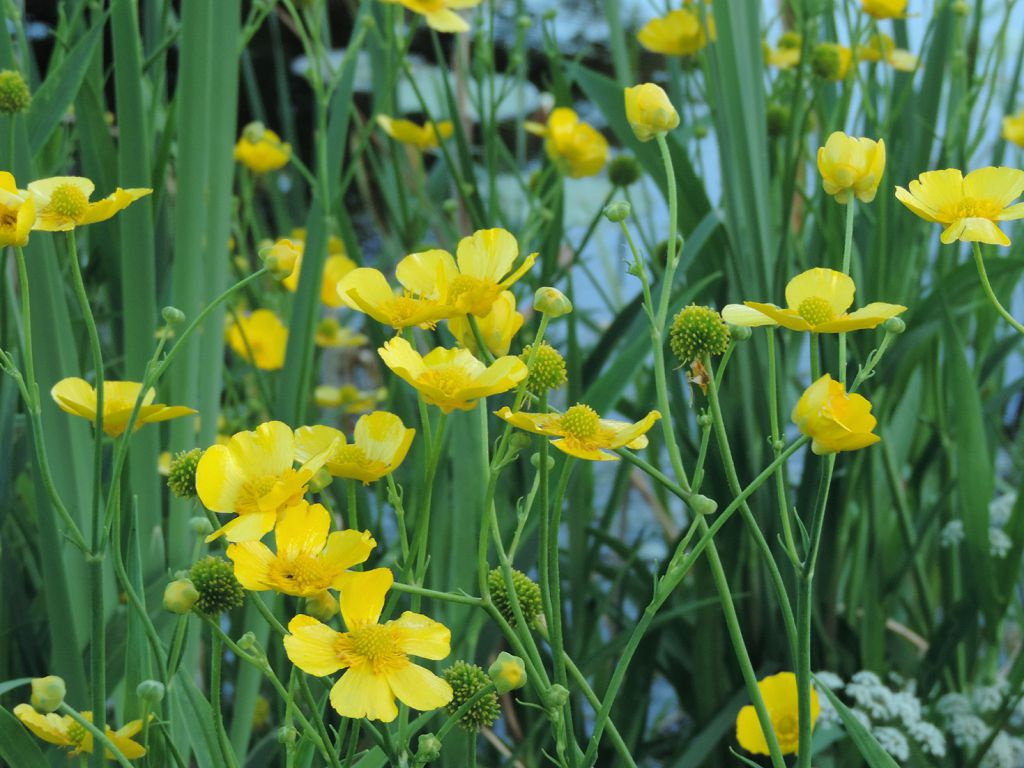

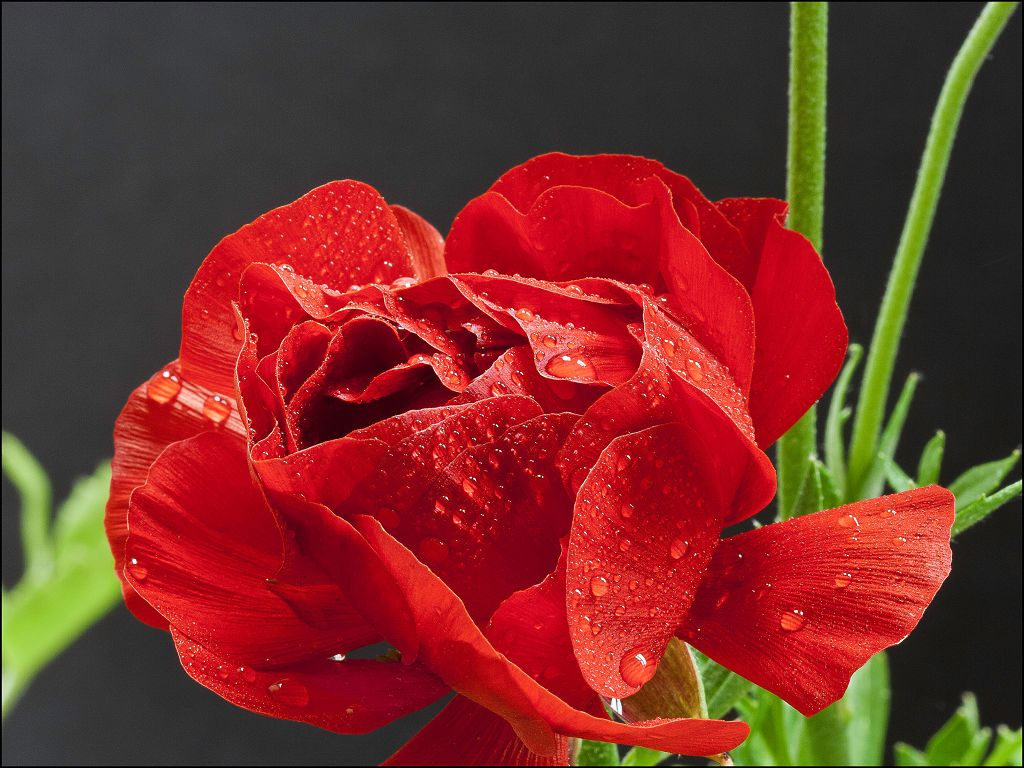
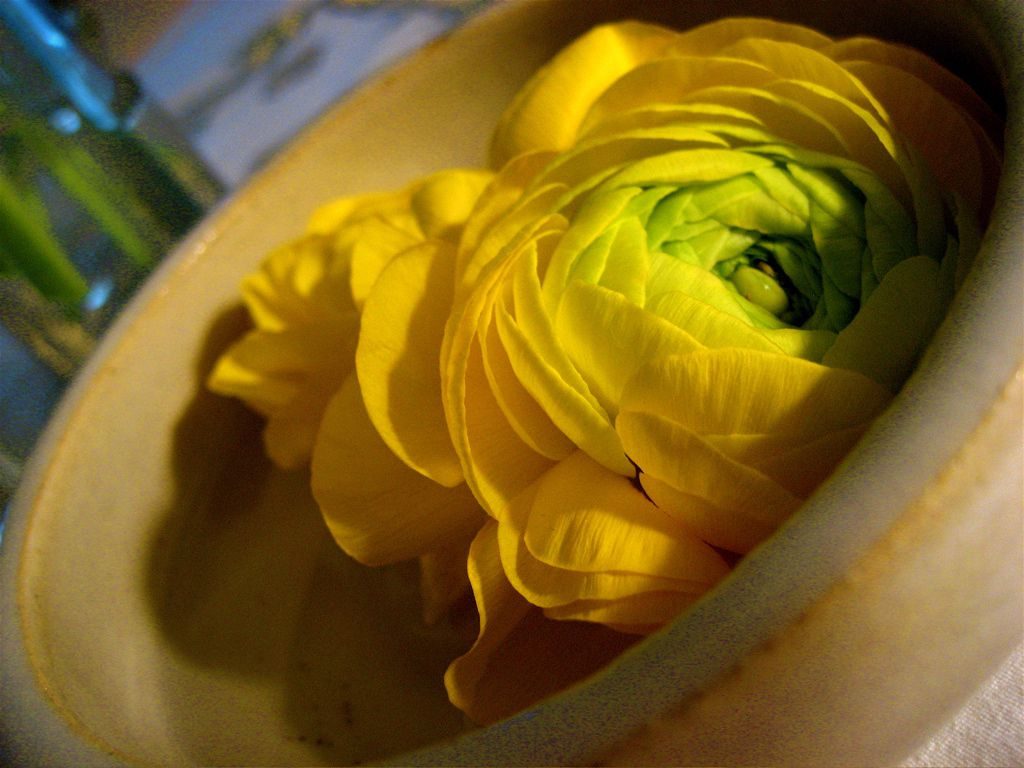
After pollination by insects form complex fruits - polynokoshki. Ripening, they burst on their own, freeing fuzzy bulging seeds. There are several dozen of them in each fruit.
Attention! Buttercup juice is poisonous. Its name comes from the word "fierce", capable of destroying the animal and man. It can cause irritation on the skin and poisoning, therefore, all work is carried out with gloves, and also is not allowed to the colors of animals and children.
Classic views
Already today more than 400 species of plants are included in the genus of buttercup, and the list continues to grow.
Buttercup caustic (night blindness). Herbaceous perennial 20-50 cm tall consists of upright, branched stems. Foliage is located throughout the height of the shoots, but quite rare. Below it is larger, almost integral. Upper leaflets strongly dissected, with linear lobes. In June, simple yellow flowers appear with 5 broad petals. In diameter, they do not exceed 2 cm.
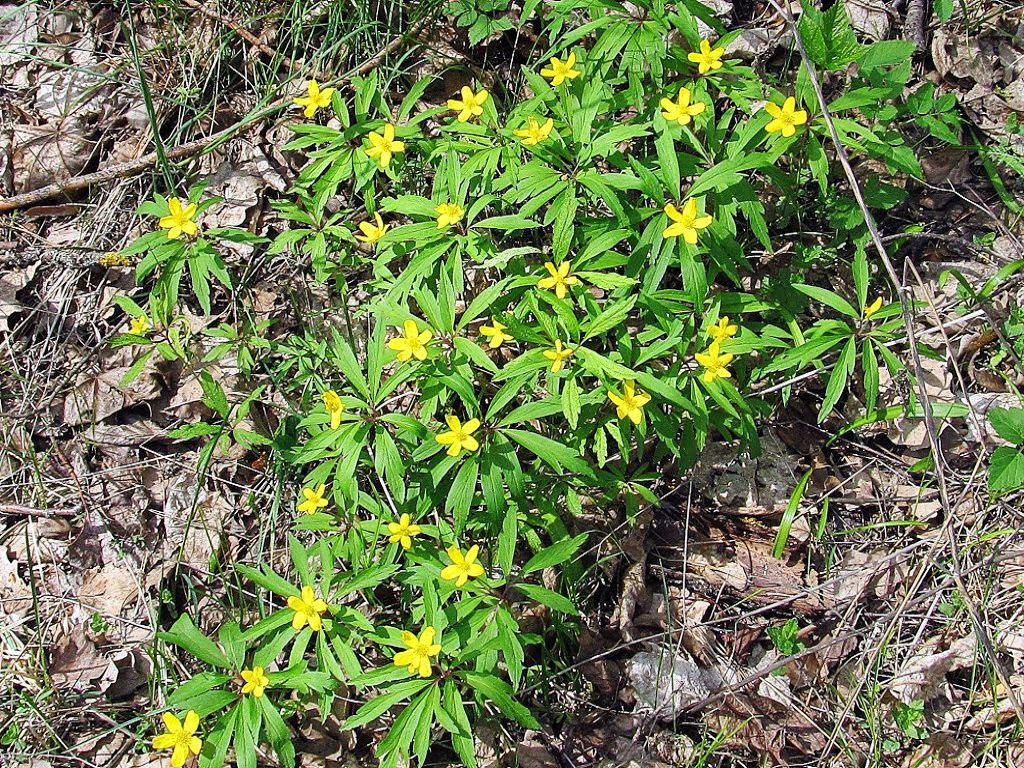
Buttercup golden (yellow). The inhabitant of wet shady meadows grows up to 40 cm in height. There are almost no leaves on a straight stalk. The rosette consists of rounded toothed leaves on long petioles. At the top is linear sessile foliage. Small yellow flowers have a pubescent cup and a simple bell-shaped corolla. They bloom in April-June.
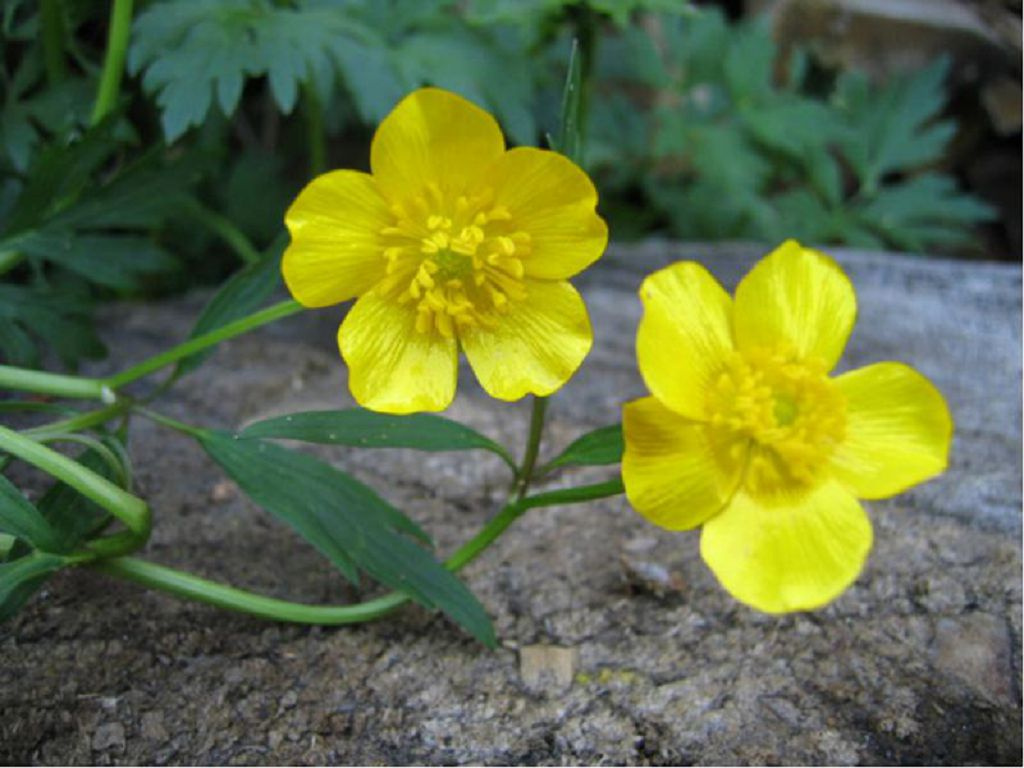
A perennial plant with lodging shoots 15-40 cm in height is easily rooted in the nodes upon contact with the soil. The stem is covered with a short nap. Chereshkovaya bright green foliage grows along the entire length. The correct simple yellow flowers consist of 5 petals. They are revealed at the beginning of summer.
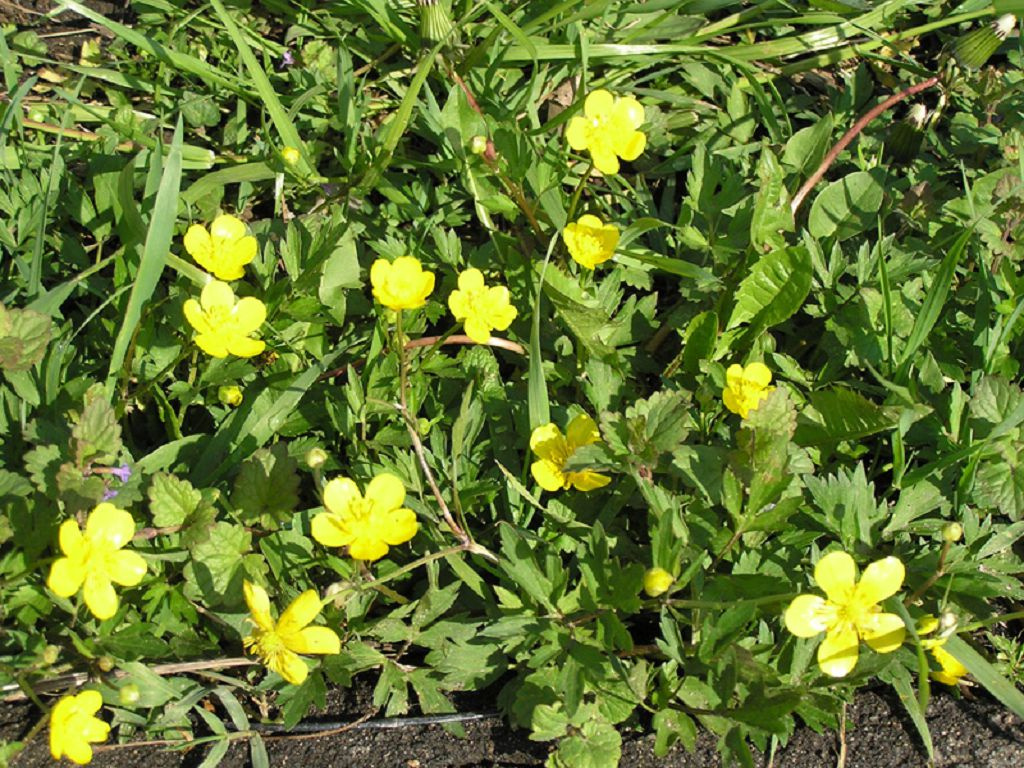
Young or annual plant with erect branched stem grows 10-70 cm in height. On the shoots are delicate trifoliate leaves with serrated sides. The ovate broad lobes are colored dark green. In May-June, small umbrella-shaped inflorescences with small (7-10 mm wide) light yellow flowers appear on the tops of the shoots.
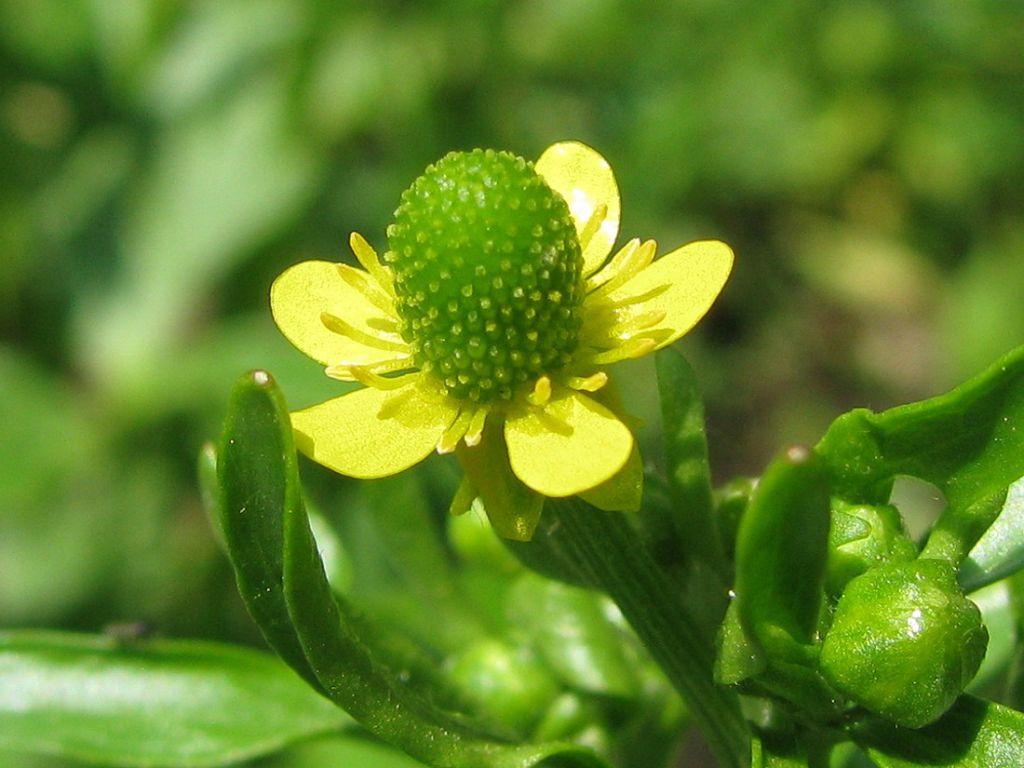
Buttercup Asian (asiaticus). Perennial with branched erect stems up to 45 cm in height grows bright green pubescent leaves. In July, flowers bloom, arranged singly or 2-4 pieces per inflorescence. They have a variety of colors and grow 4-6 cm in diameter.
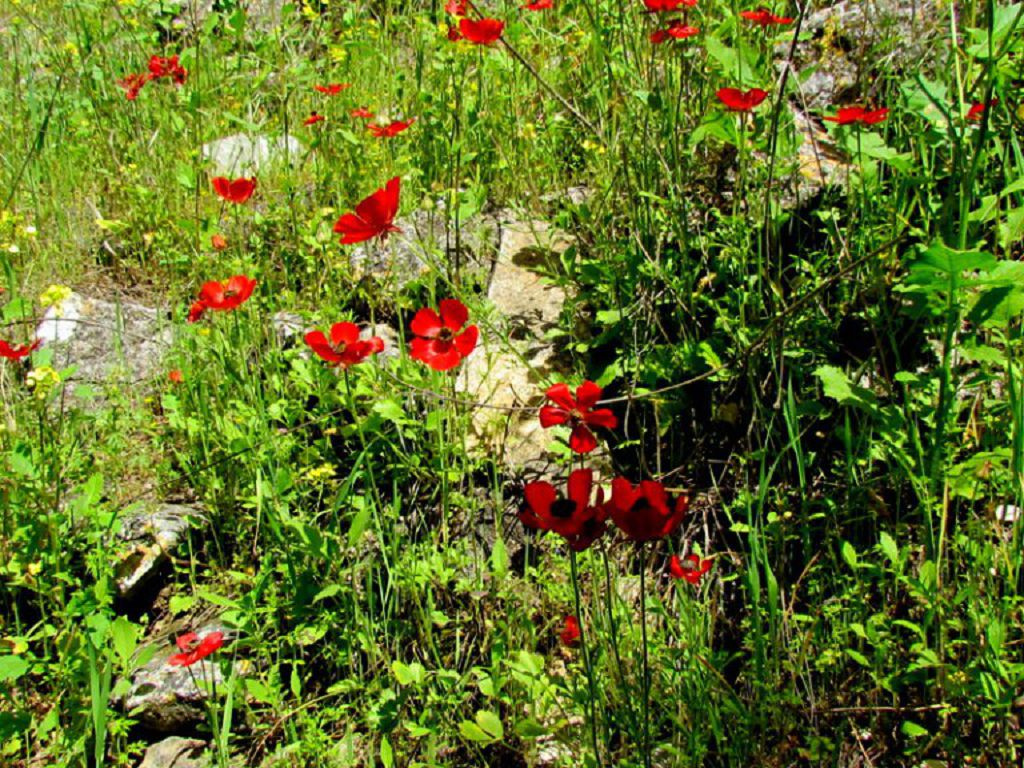
A perennial plant with a bare ascending or erect stem grows 20-50 cm in height. Foliage has a diamond or oval shape. The lower leaflets are fastened with long petioles, while the upper ones sit on the stem. Small flowers (0.8-1.2 cm) grow singly and are colored yellow. The sap of the plant is poisonous and irritating to the skin.
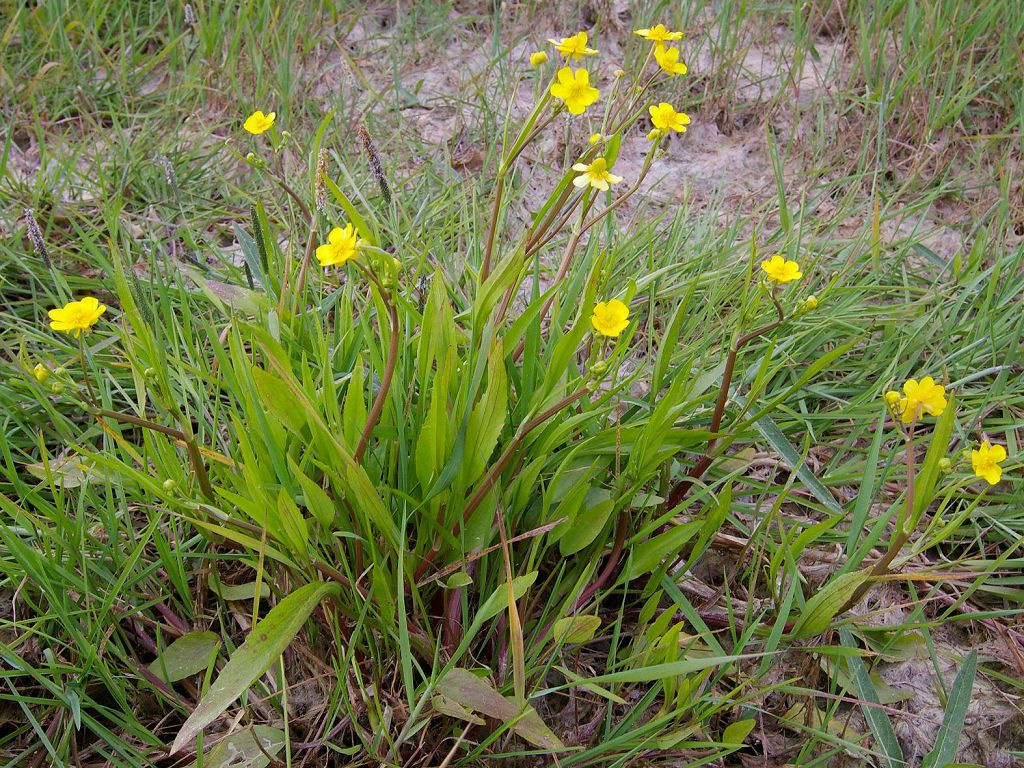
The inhabitant of the marshy reservoirs of Australia due to creeping shoots differs in very modest size. Its height is about 5-20 cm. On straight petioles, carved leaves similar to green snowflakes grow. The plant looks quite decorative and is often used in aquarium.
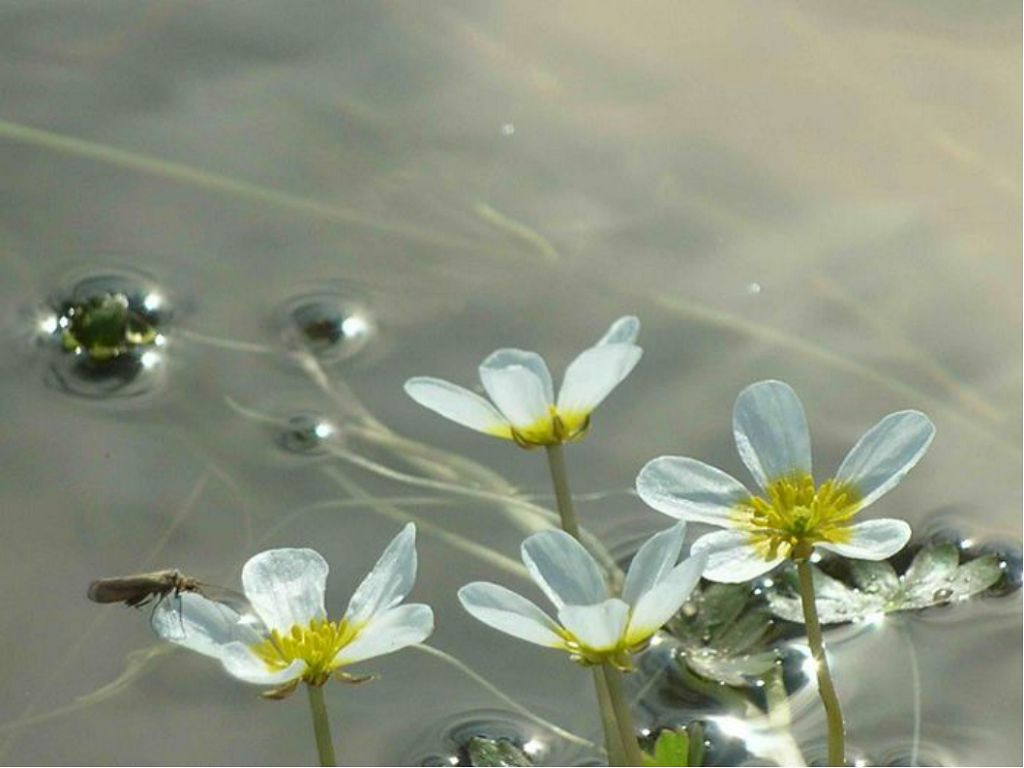
Grassy perennial 40-80 cm in height consists of upright, branched stems with a short nap. Palmate-dissected foliage is also pubescent. It has elongated lanceolate lobes with incised edges. Simple bright yellow flowers adorn the plant from June to August.
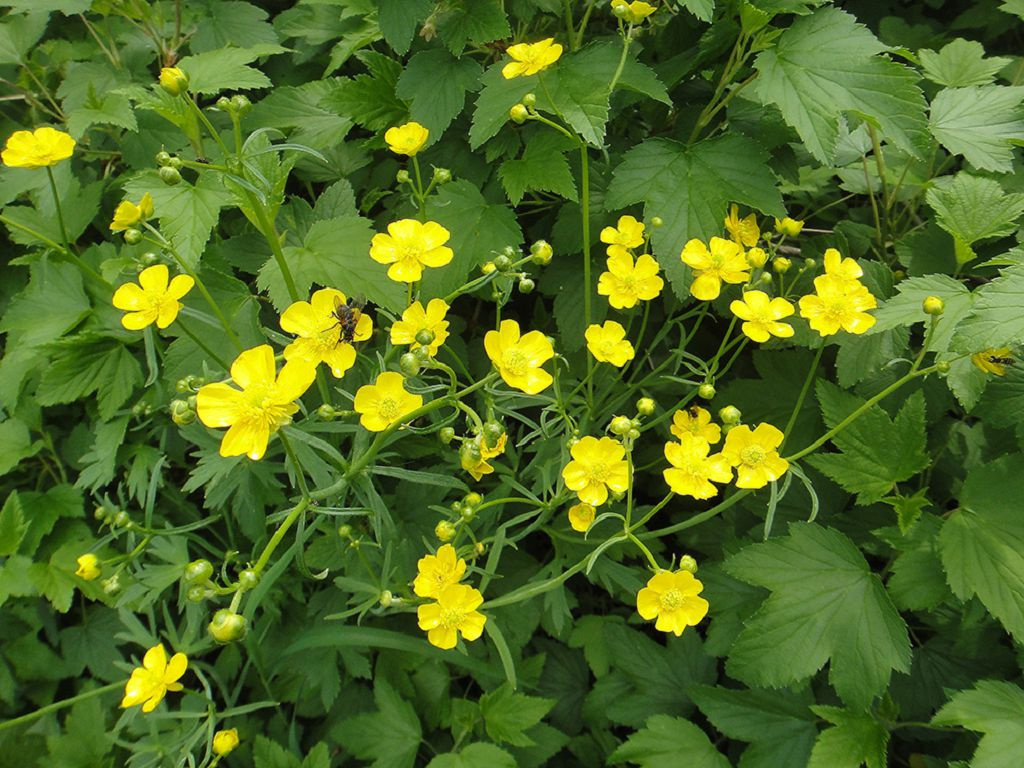
A flowering plant with curved stems 20-30 cm tall grows leaves of a round or heart-shaped form with a diameter of 2-3 cm. The lower ones are located on long petioles, the upper ones are sessile. In early summer, single yellow flowers appear with a hairy receptacle.
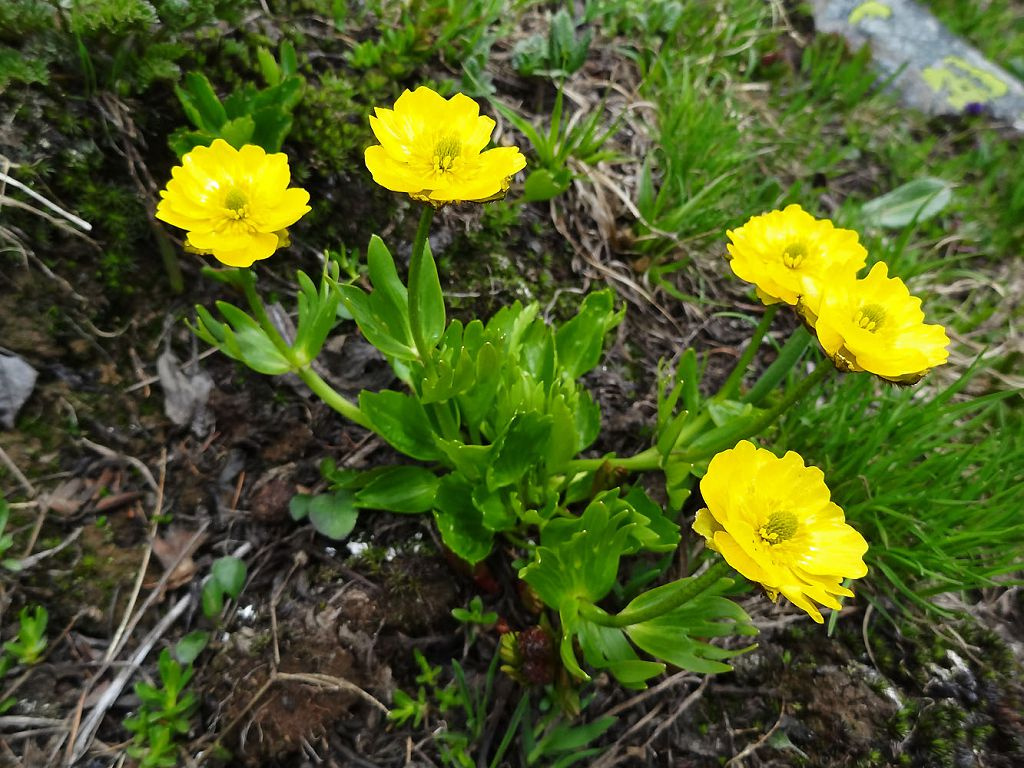
A perennial plant with a straight stem branched only in the upper part, 30-60 cm high. Whole leaves are round or heart-shaped, located on the petioles at the base of the shoot. Upper leaflets - palmately dissected, small. Single flowers of a light yellow shade in diameter are 2-3 cm. They bloom in April.
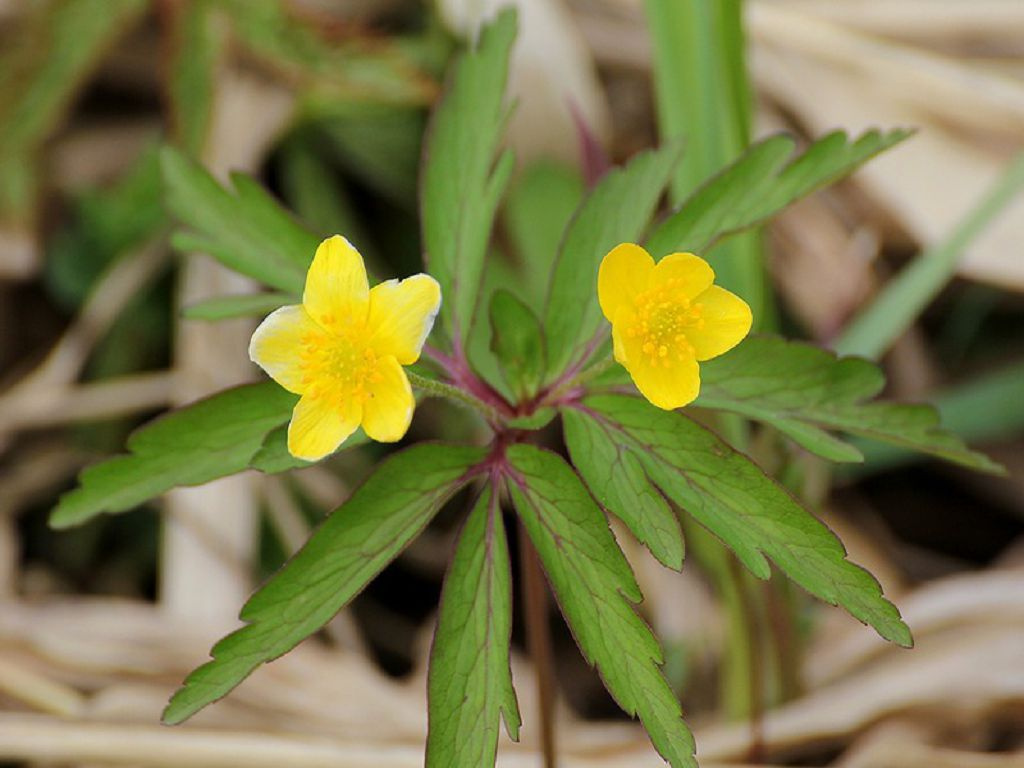
Decorative Garden Buttercup
This group of plants is highly decorative and most common among gardeners. The most interesting varieties:
- Buttercup Masha. Compact plant with a branched stem up to 30-40 cm in height dissolves terry flowers with white petals and a bright border.
- Buttercup terry (pionovidny). Large monochromatic flowers with close-fitting petals.
- French. Semi-double flowers consist of 2-3 rows of wide petals.
- Persian. Small simple or semi-double flowers.
- Chalmoid. Blossoms in densely colored, spherical flowers.
Breeding methods
Buttercup is propagated by seed and rhizome division. Since most ornamental buttercups do not transmit varietal properties to offspring, purchased seeds are needed for sowing.

Pre-grown seedlings. To do this, in the second half of February, seeds are sown in boxes with sandy-peat or loose garden soil and sprinkled with a thin layer of earth. They are carefully watered and covered with a transparent material. Greenhouse contain in a bright place with a temperature of + 10 ... + 12 ° C. Shoots appear fairly amicably in 15-20 days. From this moment on, the shelter is removed and the pot is transferred to a warmer (+ 20 ° C) room. The lighting should be diffused, but rather intense. If necessary, use fitolampy. When 4-5 leaves appear on the seedlings, they dive into separate peat pots.
Every year, new tuberous growths are formed on the roots. When excavated in September, they are separated. In the frosty winter, the roots do not survive outside. A cool room (+ 19 ... + 21 ° C) is more suitable for them. In the spring, bumps are planted on a flower bed.
Planting and maintenance in the open field
Buttercups are planted in the garden at the end of May, when the probability of frost will finally disappear. Pick up sunny or slightly darkened areas with good protection against drafts. Constant exposure to direct sunlight is undesirable, since flowering will be short-lived and less abundant.
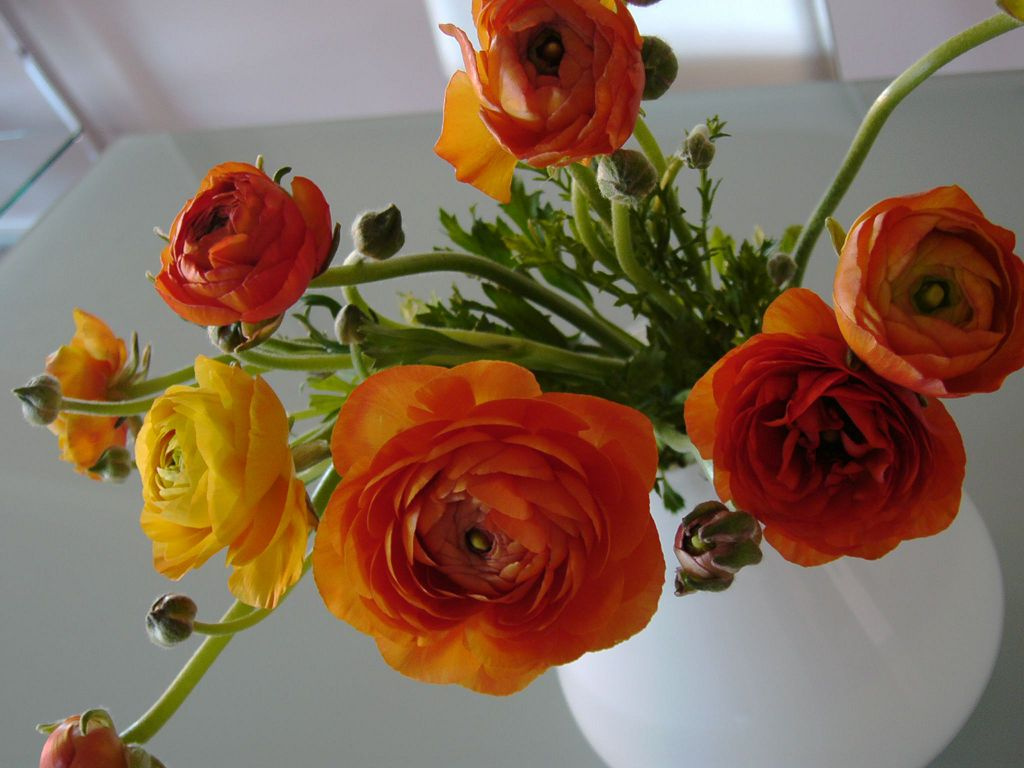
The soil should be neutral or slightly acidic. Close groundwater is contraindicated. It is best to choose fairly loose, nutrient soils with moderate humidity. The site is digged in advance and prepare pits to the depth of the root system. The distance between the plants is 15-20 cm. Some sand or vermiculite is poured at the bottom of each pit. Landing is best done with a pot or a large lump of earth flush with the root neck.
The nodules are presoaked for 12 hours in warm water with potassium permanganate and a growth stimulator. They are planted to a depth of 8-10 cm. The soil is tamped and watered abundantly.
Further care of the plant is not very burdensome. Periodically should weed the beds, remove weeds and break the crust on the surface of the earth.
Watering should be moderate. Only in the absence of precipitation, the flower bed is watered twice a week. Since August, it is necessary to water the plants much less frequently so that the tubers ripen and do not rot. During prolonged rainy weather, planting is covered with a film.
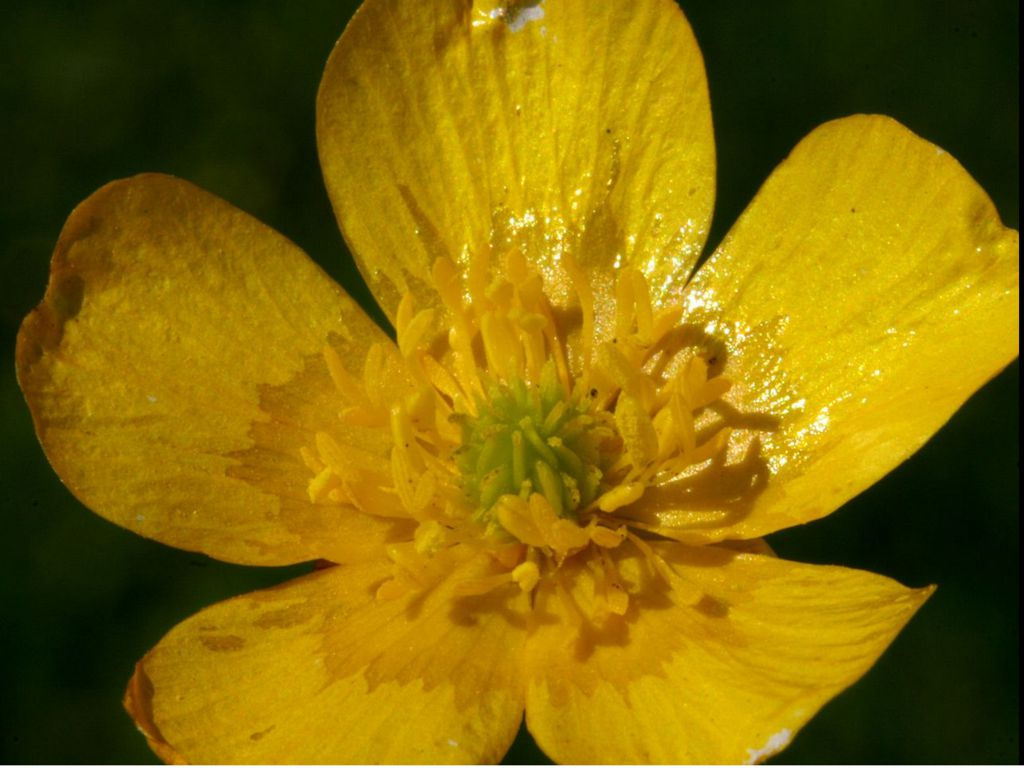
Every 15-20 days the buttercup is fed with mineral complexes. At the beginning of growth, nitrogenous compounds are used, and with the advent of buds, they switch to potassium-phosphoric ones.
To flower bed looked neat, followed immediately cut off the faded flowers.
Buttercups are quite heat-loving plants, so they cannot spend the winter in open ground. In the autumn, when the entire ground part begins to dry, the tubers are dug out. They are dried in a ventilated place and stored in a cloth or pots with a cake.
Buttercup rarely suffers, mainly fungal infections that develop with regular flooding of the soil. The first signal is dropping even unblown buds and flowers. Also on the leaves and stalks may appear brown or whitish plaques. When a disease is detected, it is necessary to temporarily stop watering and treat it with a fungicide.

Beneficial features
Although buttercup is considered a poisonous plant, in small quantities it can have a positive effect on the body. It is used in folk and official medicine. The juice contains saponins, fatty oils, tannins, glycosides, ascorbic acid. Taking the drugs orally stimulates the production of hemoglobin and stabilizes the nervous system. Outwardly use fresh leaves and lotions with decoctions and water infusions. They help fight diseases of the joints, gout, lupus, scabies, calluses.
It is very important not to exceed the dosage, so it is better to use pharmaceuticals, rather than self-made. Also, treatment with buttercup is contraindicated for pregnant and lactating women, as well as people prone to allergies.
Use in the garden
Garden terry or simple buttercups with large, bright flowers will be a wonderful decoration of a mixed flower bed. Depending on their height, they are used on the front or central plan of the flower garden, as well as in rock arias, alpine gardens or mixborders. Some species are successfully cultivated in pots, as indoor plants. Buttercup in a flower bed is usually combined with bells, cornflowers, hosts, evergreen shrubs.
Buttercup creeping is a perennial herb, endowed with hooked roots. The stem of this plant is high, its height will fluctuate between thirty and eighty centimeters. Such a creeping buttercup stalk will be branched, straight and furrowed, it can be either naked or endowed with distal hairs to the middle. The basal leaves of this plant are endowed with a rounded heart-shaped plate in outline and a rather long, bulged hairy stem. Bottom leaves almost to the very base will be three- and five-membered lobes, which will be elongated lanceolate and upward somewhat broadening, as well as also notched serrated. The upper stem leaves of a creeping buttercup will be two-fold and four-split into toothed or linear-lanceolate whole lobes. It is noteworthy that the leaves of this plant are endowed with pressed hairs on both sides, and from below they will be painted in pale green tones. Peduncles of this plant are endowed with adpressed hairs. Usually creeping buttercup flowers will be numerous, and their diameter is about two to three centimeters. The sepals of this plant are blunt, ovoid, on the edge they will be endowed with distant hairs. Most often, creeping buttercup petals are only five to seven pieces, and they will be painted in bright yellow tones. It is noteworthy that the receptacle of this plant is hairy. The fruit of a creeping buttercup is a group seed, which will consist of many seeds.Under natural conditions, this plant is found on the territory of Western Siberia, the mountains of Central Asia, in the south of Eastern Siberia, in the European part of Russia, in Ukraine and in Belarus. For growth, this plant prefers light forests, meadows, edges, glades, embankments, gardens, places among fields, dry flood plain and dry meadows.
The flowering of a creeping buttercup falls on a period starting in June and ending in August.
Description of the medicinal properties of creeping buttercup
Buttercup creeping endowed with very valuable healing properties, while for therapeutic purposes it is recommended to use the grass of this plant. The concept of grass includes flowers, leaves and stems of this plant. It is recommended to harvest such medicinal raw materials throughout the entire period of flowering of the creeping buttercup.The presence of such valuable healing properties should be explained by the content of carotene, quinoin, saponins, ascorbic acid, tannins, coumarins, alkaloids, flavonoids and lactones in the composition of this plant.
It should be noted that this plant is poisonous, for this reason it is recommended to exercise extreme caution when handling this plant. creeping buttercup grass should be used externally and as compresses for gout, rheumatism, wounds, boils, headache and neuralgia.
A decoction made on the basis of creeping buttercup grass is recommended for washing the skin that has been affected by scabies. In addition, it is recommended and apply the crushed fresh leaves of this plant to abscesses and abscesses in order to accelerate their maturation. With proper use of such curative remedies based on a creeping buttercup, they are very effective and the positive effect will be noticeable rather quickly.
Other plant names:
fierce color, night blindness
Short description of a creeping buttercup:
Buttercup creeping (fierce color) - It is a perennial herbaceous plant 15–40 cm tall with a short branched rhizome. Stem ascending or creeping, often rooting, naked or sometimes pubescent.
Basal leaves are petiolate, trifoliate, consisting of rhombic-ovate, deeply trifoliate, unequal-toothed leaf lobes. Upper leaves sessile, lanceolate, tridentary. The flowers are bisexual, regular, five-membered, 2–3 cm in diameter. The cup is pubescent, the rim is golden-yellow, brilliant. The fruit is a bare, single-seeded leaflet with a short spout.
It blooms from May to October.
Places of growth:
It grows on wet, shaded, alluvial soils: along the banks of rivers and lakes, in wet meadows, in bushland, in forest swamps.
Buttercup billet:
For therapeutic purposes, the grass is harvested during the flowering period, less often the leaves and flowers, use them fresh or dried.
The chemical composition of the creeping buttercup:
Like other buttercups, the fresh grass of this plant contains protoanemonin (relatively little), coumarins, cardiac glycosides (cardenolides), saponins, and a substance that releases prussic acid during cleavage.
Tannins, alkaloids (0.1%), coumarins (umbelliferone, scopoletin), flavonoids (vitexin, saponaretin, neovitexin), ascorbic acid, carotene, quinoin, saponins and lactones (ranunculin, protoanoneone) are found in the grass of a creeping buttercup.
All these active ingredients form the basis of the chemical composition of the creeping buttercup (fierce color).
Pharmacological properties of creeping buttercup:
Pharmacological properties of buttercup are determined by its chemical composition.
In therapeutic doses, buttercups have analgesic, antimicrobial, wound healing and tonic properties.
Application of a buttercup in medicine, treatment with a buttercup:
In rheumatism, scrofula, scabies are applied to sucking tumors, to the boils, creeping grass buttercup with a creeping stem. Apply only as external.
Broth herbs wash areas of the skin affected by scabies. In folk medicine, it is known as a cure for malaria.
In case of fungal skin lesions in the form of washing or less often - in the form of compresses, medicines from creeping buttercup are used in oriental medicine.
For headaches, dropsy, edema and diseases of the female genital organs, the plant uses Tibetan medicine.
Dosage forms, method of administration and doses of creeping buttercup drugs:
From grass, leaves and flowers of buttercup are made effective medicines and forms used in the treatment of many diseases. Consider the main ones.
Fresh buttercup leaves:
Crushed fresh buttercup leaves are applied to the tumors for their resorption and to the boils to accelerate their maturation; to abscesses, abscesses to accelerate their maturation.
Fresh herb buttercup:
Fresh grass is used only as an external remedy in the form of compresses for radiculitis, sciatica, myositis, osteochondrosis, arthritis, rheumatic pains, scrofula, as an exhaust and analgesic for mastitis, headache, and tumors.
Pounded ground parts of the plant:
Pounded above-ground parts (i.e., flowers, stems, leaves) of caustic buttercup and creeping buttercup are used in place of mustard plaster and blister plaster, as well as when rubbing the legs with aches.
Buttercup herb decoction:
Buttercup herb decoction (1:10) is used to wash body parts affected by scabies and diathesis.
A decoction of dry grass or buttercup flowers creeping:
A decoction of dry grass or flowers of creeping buttercup: brew 1 cup boiling water 1 tsp. grass or flowers, insist, wrapped, 30 min, drain. Drink 1 tbsp. l 3 times a day for epilepsy, headaches, as a diuretic for dropsy and edema, for uterine and other bleeding.
Buttercup Flowers Creeping:
Buttercup creeping flowers are used as a remedy for malaria - 8-10 hours before an attack, pounded fresh flowers are applied to the wrists, in the area where the pulse is probed.
Fresh herb buttercup juice:
Fresh grass juice (or gruel) is used for warts, scabies, scrofula. The plant is also prescribed as a remedy for abscesses.
Contraindications creeping buttercup:
The plant should be used very carefully, as it is possible to cause a burn with the formation of blisters and even the appearance of ulcers.
Symptoms of poisoning and methods of treatment, see. Buttercup poisonous.
With scrofula, rheumatism and scabies, a buttercup creeping is applied to sore areas of the skin, tumor and boils. The stem is applied to dissolve abscesses or accelerate their maturation. To drink 1 teaspoon of dried leaves and flowers brewed with a glass of boiling water, then the infusion is wrapped and infused for 30 minutes, then filtered and drunk 1 tbsp. spoon thrice a day for headache, epilepsy.
Important! When applying a creeping buttercup when it is applied to the skin, it cannot be used for a long time, as the plant irritates the skin, sometimes leads to tissue necrosis and ulceration.
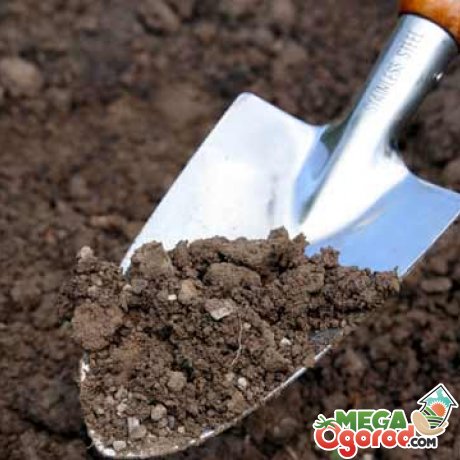
Buttercup most like shaded areas, but plants can also grow in the sun. But it should be remembered that buttercups bloom in very bright light for long. Still plants do not tolerate drafts.
It is best to plant them under a tree that has a wide, but not too thick crown.
Buttercups require loose and soft earth. They do not like sandy or loamy soil. It is required to pour sand and peat ground into heavy soils. It is necessary that the soil during irrigation absorbs moisture, but it did not linger in the ground.
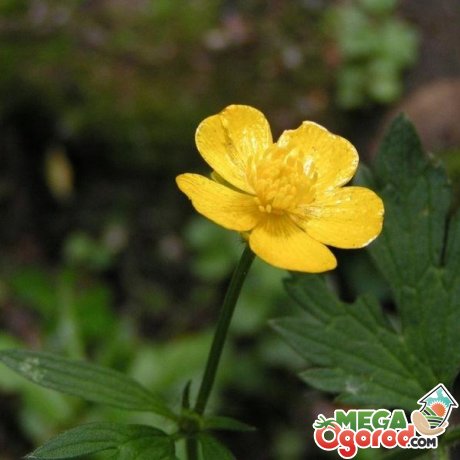
Buttercups seeds are sown in containers at home in February and April or by root cuttings in August and September. Adult plants are propagated by division. Seed propagation is rarely used, since the seeds germinate very poorly.
Proper reproduction of buttercups creeping seeds:
- Sow seeds in the tank in late winter and early March.
- Seeds poured grooves, and then sprinkled with a layer of earth 2 cm.
- The temperature of the room at this time they require a low + 10-15 ° C.
- Capacities with seedlings cover with a film.
- After 2-3 weeks, the containers are placed in a warmer room, having a temperature of +20 ° C.
The seedlings grown in the house are placed in the ground in spring, when the ground warms up by 6-8 cm, as buttercups prefer to grow in heat. This can be done in late April or early May. If there is a risk of frost, then planting on top is covered with straw. For planting dig holes 5 cm deep. Indent between the pits make 10 cm. They put the drainage of gravel. After planting sprouts grown from seed.
Planting tubers:
- Before planting, the tubers are placed in water at room temperature for 10 hours.
- Swollen tubers are planted in a hole 5 cm deep.
- Tubers need to have legs down, otherwise they will not germinate.
- After planting, it is advised to water the soil with a small amount of water.
When planting tubers shoots appear in 1.5-2 weeks. The larger tuber you planted, the greater the number of flowers bloom on this plant. Flowers bloom in 2.5 months. And by the end of August the fruits of many-ripened fruits ripen, in one many-tip contains 500 small seeds.
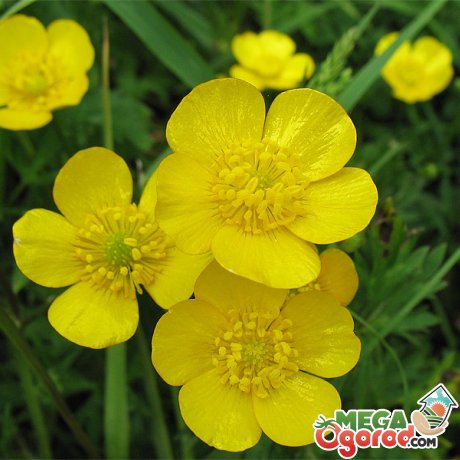
It is easy to care for a buttercup, even beginners can grow it:
- Watering Watering should be intensive and regular, but not overflowing the plants, as they can rot the roots. If you still watered with too much water, then immediately dig up the buttercups, wash the roots, process the solution of potassium permanganate and leave for 2-3 hours to dry the roots. Then put it in the ground again. Even plants do not tolerate drought, they dry and die rhizomes. fungicide. Put the tubers in bags made of polyethylene, cover with sand or peat ground and place until spring in a cool room with an air temperature of + 5-10 ° C. Or just put in a drawer and sprinkle with peat. You can put the boxes in the basement or cellar. From time to time, inspect the tubers to detect any diseases. If diseases are found, treat the affected areas with brilliant green or colloidal sulfur. If almost the entire root is sick, then destroy it, and pour new peat or sand into the boxes.
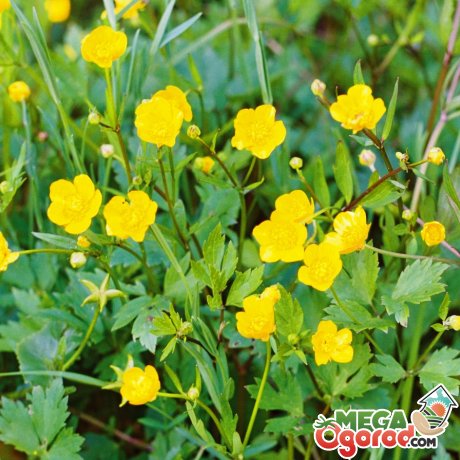
Buttercups can be damaged by various diseases and pests:
- Blackleg. When it is in a young seedling at the bottom of the stem, white spots are visible, which then turn brown and the plants die.
- Root rot. With this disease, plants grow slowly, then turn yellow, and then die. Buttercups can not be planted in the ground with fresh manure, so they do not get sick root rot.
- Fusarium wilt. When the disease on the leaves and stalks are visible brown specks. The plant develops more slowly, and then dies.
- Mealy dew. When the disease on the leaves and petioles visible mealy patina, and then there are black dots.
- Perinosporosis. In case of illness, plants lag behind, spots appear on the leaves.
- Rust. When it fistulas form on the leaves, when they crack, then rust-colored powder begins to crumble from them.
These are tiny worms that grow and develop with an excess of moisture. A plant affected by nematodes may die.
Nematophagin BT is well suited for the destruction of nematodes. It is brought into the ground to a depth of 15-20 cm before planting seedlings, and if the plant is already planted, then make holes and make them into the substance. The drug is safe for animals, people and beneficial insects.
For all these diseases, biological fungicides are used: Baktofit, Fitop, Barrier, Fitosporin, Planzir, Zaslon, Integral, Agat, Trikhodermin. They have a good effect on fungal diseases and have low toxicity.
Even a beginner can grow it. The most important thing is to plant it in the right place and water it properly, since it does not like drought and overflow.
More information can be found in the video:
The name of this wild flower can be found in songs and poems, although it was washed away not at all romantic - the buttercup is nicknamed so for the “fierce” poisonous juice, which is eating away at the skin. However, the attractive appearance of the plant at all times prompted the rural young men to collect it in bouquets and give to their beloved girls. Folk healers and healers tear buttercups for another purpose - for the preparation of raw materials and the preparation of medicinal decoctions, tinctures and ointments. Today we will tell you all about the beneficial properties of buttercup and its application in medicine.
Full description of buttercup
The plant buttercup belongs to the family of the same name, and in Latin it is called ranunculus, which means “little frog”. It is not the green color or the specific shape of the flowers that causes such a funny name. It is all about the buttercup's devoted love for wet soil and sunlight. Like a frog basking on a mossy stone, the buttercup settles along the shores of shallow, marshy reservoirs, and stretches its delicate petals to the warm sun.
Appearance
Buttercup is an annual or perennial herb with a common or tuberous rhizome, with a branchy straight or open stem. Buttercup height can reach one meter in height, but more often it is a short growing flower (20-30 cm). The shape of the leaves of the buttercup is very diverse, and, with the same plant, the lower castings can be long, palmar or shovel-like, and the upper ones - short and pinnate. Their length and width does not exceed six centimeters, and in the place of attachment to the stem there is a so-called “honey” fossa covered with a thin scale.
Bright, beautiful flowers of a buttercup differ in the correct form, but the tiny size - no more than two centimeters in the diameter. They can grow alone or gather in lush inflorescences. At the end of flowering the fruits are tied, which in biology are called "multi-webs". When they ripen and burst, seeds, usually covered with fine hairs and slightly convex, spill onto the ground. Each multi-tip contains several dozen seeds, so reproduction doesn’t cause problems with a buttercup.
Color spectrum
Usually with the word “buttercup” we imagine small yellow-orange flowers, but the color range of these plants is very extensive. In nature, there are also white, bright red, pale pink, sky blue and even lilac buttercups.
Habitats
Buttercup is a frequent guest of green meadows, river valleys and swampy backwaters throughout Europe, especially in the Alps and the Pyrenees. This plant is found in Asia, and in the North Caucasus, and in Western Siberia. Buttercup grows almost throughout the northern hemisphere, it is not only in the Far North and the hot south, where the climate is really quite unsuitable. Buttercup is well known to the people of Russia - these flowers can be found on almost every field, especially if the river crosses it, or there is a swamp nearby.
Types of buttercup
Science knows about six hundred types of buttercup, they are all poisonous to varying degrees, and useful to varying degrees. Traditional medicine in many countries of the world has adopted these flowers, they have found their place in the bins of Russian healers.
Currently, the following types of buttercup are used to treat a wide range of diseases:
Marsh;
Creeping;
Multicolored.
Caustic (night blindness);
Poisonous;
Buttercup caustic (night blindness)

Night blindness has the scientific name ranunculus acris and a very wide range of habitats. It is the caustic buttercup that is best known to the average person, and just his golden-sunny petals make us consider all buttercups yellow. Night blindness is one of the most tall plants of the buttercup family; for an adult, it can reach to the waist. Buttercup stem caustic straight, ascending, covered with thin adherent hairs and branching at the end. The leaves have an irregular shape and normally can be very different from each other.
The rhizome of night blindness is very short for such a tall plant; it consists of numerous filamentous processes gathered in a bundle. Bright flowers most often appear at the ends of the branches separately, they almost never form large inflorescences. What is a pretty plant called "night blindness"? Of course, for the ability of poisonous juice to irritate the mucous membranes. If after the collection of buttercup caustic to rub your eyes, they will be very watery due to the alkaloid protoanemonin. In the countryside since ancient times there is an opinion that chickens should not be allowed to graze on the buttercup field, otherwise they will become blind. But science, this "horror story" is not confirmed.
Application of buttercup caustic in medicine
For medical purposes, stems and leaves of night blindness are used, the juice of which contains alkaloids, saponins, flavonoids, glycosides and tannins. The main alkaloid in the composition of buttercup caustic is called protoanemonin, and it has a direct relationship to poisonous sea anemones.
Buttercup caustic has the following beneficial effects on the human body:
Tonic;
Bactericidal;
Anti-inflammatory;
Immunostimulating;
Hemostatic;
Accelerating metabolic processes;
Stimulating blood formation and elevated hemoglobin level.
Drugs based on caustic buttercup are used to treat the following diseases:
Inflammation of the lymph nodes;
Hydradenitis;
Enlarged spleen;
Buttercup poisonous
The scientific name of this type of buttercup is ranunculus sceleratu. One-two-year-old low (10-70 cm) plant with a branchy, hollow stem inside blooms with tiny (7-10 mm) flowers of pale yellow color. But the leaves of a buttercup are poisonous, bright green, shiny and more juicy and fleshy than in chicken blindness, so you can get more juice from them. By the way, it contains a lot more poisonous alkaloids than in the juice of the previously described species, so the buttercup is so called.
It is interesting! Buttercup poisonous fluffy seeds that do not get wet in the water and do not rot. Moreover, under the top layer of their skin there are special cells in the form of empty cones, thanks to which the seeds cannot drown in water.
The use of buttercup poisonous in medicine
A weaker solution of juice of a buttercup poisonous is excellent for washing the eyes during barley and disinfecting purulent wounds. If an abscess is ripening on the skin, it is necessary to attach crushed fresh grass to this place and tie it overnight. The poisonous juice will stretch the inflammation out, and the painful abscess will open. Freshly squeezed concentrated juice of poisonous buttercup can also be removed by warts, if applied regularly, several times a day. And in a hot infusion of buttercup poisonous, it is good to soar your feet for a night with rheumatism.
Important! For internal use, you must first dry the raw material so that volatile alkaloids evaporate from the poisonous buttercup.
Broths and infusions of dried plants have to help with the following diseases:
Buttercup creeping

Buttercup creeping (ranunculus repens) is no less poisonous than the above described species, but it is called that because of the short stems that often rooted on the ground. Thus, it can be said that the creeping buttercup has a combined type of reproduction - vegetative-seed. It does not need a lot of seeds, so the plant blooms large for buttercup (2 cm in diameter) with single honey-yellow flowers crowning each stalk. Flowering continues for a long time - from late spring to late summer. Buttercup is creeping, and unlike its counterparts, it doesn’t like the sun; it prefers the shady shores of forest lakes and marshes.
Application of buttercup creeping in medicine
The juice of this plant perfectly kills germs, and also tones the body, heals and anesthetizes wounds. The warts are removed with crushed fresh grass, they are treated with scabies with diluted juice, and from pulpy stems they are made into a mush and primed to furuncles and abscesses so that they quickly matured and opened. Creeping buttercup compresses relieve joint and back pain well, and washing and bath effectively kills the fungus on the legs.
External application of creeping buttercup helps to alleviate the course of the following diseases:
Scrofula;
To prepare the infusion for internal use, you need to take either only flowers of creeping buttercup, or dried grass. For a glass of boiling water you will need one teaspoon of crushed raw materials. Dishes with infusion should be wrapped warmly for half an hour immediately after steaming, and then strain (very carefully!) And take one tablespoon three times a day before meals. This remedy perfectly helps with chronic headaches, migraines, dropsy, gastric and intestinal bleeding.
Fresh flowers of a creeping buttercup significantly alleviate the condition of malaria patients. Since the attacks of this disease overwhelm the person mainly in the evenings, in the morning you need to chop the flowers and attach the resulting gruel to the inner side of the wrists and elbows, where the large blood vessels pass. This simple way can prevent or at least mitigate the attack of malaria.
When applying externally concentrated juice of a creeping buttercup, this highly toxic substance should not be left on the skin for more than fifteen minutes, otherwise ulceration or even will develop.
Banewort
In Latin, the buttercup hot is called ranunculus flammula. This is a compact, low (20-50 cm) plant with a vertical or slightly sloping stem and two types of leaves: the lower long-petiolate, and the upper - wide and sessile. Buttercup blooms with single small (12 mm in diameter) pale yellow or lemon flowers. The fruit of this plant is not at all the same as in chicken-blindness: it is not a multi-tip, but a single-seeded leaflet of an egg-shaped form. The burning flower is a big fan of dampness, he likes marshy meadows and the coast of forest lakes.
The use of buttercup hot in medicine
The plant juice contains rare beneficial substances - coumarins and gamma-lactones. They have a therapeutic effect in scurvy, and it was discovered in ancient times, when the disease was very widespread. For the treatment of scurvy, it is recommended to squeeze a few drops of juice in half a glass of water and drink this medicine before meals three times a day for a month.
The alkaloids contained in the burning buttercup cause an immune response in the body of an oncological patient, with which a person can cope with a serious illness. In the case of cancer, traditional healers advise to steam up one tablespoon of fresh crushed buttercup burning with a liter of boiling water, leave for an hour, then strain and take a tablespoon four times a day until all the medicine is drunk. After two weeks, the treatment can be repeated. We emphasize that this technique can be used only with the permission of the treating oncologist!
Buttercup multicolor
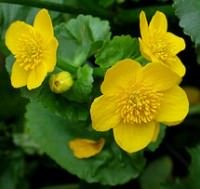
Multi-flowered buttercup (ranunculus polyanthemus) is a stately (60-100 cm) beautiful plant with a straight, pubescent stem and large (up to 3 cm in diameter) bright yellow flowers, gathered in inflorescences. The leaves of this species are long, wedge-shaped, and the stalks are also covered with fine hairs, like the stem. A multi-flowered buttercup has a short flowering period - from June to July; it does not reproduce too actively, therefore it occurs less often in nature than the above described fellows. This buttercup avoids civilization, it can be seen on forest glades and wide untouched meadows.
Application of buttercup multicolor in medicine
The stems, leaves, and flowers of a multi-flowered buttercup contain the alkaloid protoanemonin, as well as flavonoids, ascorbic acid, and carotene.
Such a rich composition makes it possible to use this plant for the treatment of many diseases:
Furunculosis;
Rheumatism;
Purulent wounds;
Tuberculosis of the skin.
Neuralgia;
Migraine;
To make a multi-flowered buttercup infusion, you need to steam two teaspoons of freshly chopped raw material with half a liter of boiling water and leave for forty minutes, and then strain it thoroughly. Take the infusion 3-4 times daily before meals, one tablespoon.
Field buttercup
The field buttercup (ranunculus arvensis) is a relatively low (up to 60 cm) plant with a vertical, strongly branched, almost bare stem and wide dissected leaves. This species blooms with single golden-yellow flowers with a diameter of about one and a half centimeters. The rhizome of the plant consists of several small tubers, in which the content of alkaloids is higher than in the aboveground part. The field buttercup received its name precisely for the love of fields, meadows and pastures. It settles in open areas and grows well even on acidic, loamy and carbonate soils.
Application of a buttercup field in medicine
The field buttercup, like all the others, tones well, disinfects and anesthetizes, but it also has two additional properties: antipyretic and laxative. Alcoholic tincture of buttercup field is used for rubbing during fever and warming compresses for sore throat, radiculitis and osteochondrosis. A slurry of fresh leaves and stems removes warts and accelerates the ripening of boils. The field buttercup tubers were not ignored either - they are industrially produced with food additives.
Buttercup marsh
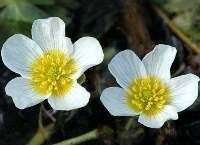
This type of buttercup is sometimes called aquatic, following the literal translation of the Latin name - ranunculus aquatica. This amazing plant is not at all like its terrestrial counterparts - it takes roots directly under water, sometimes at an impressive depth (up to two meters). Buttercup marsh has a thin bare stem and small (3-4 cm) leaves of a light green color. The scape of the leaves is about the same length as themselves. Unusual and shape - the leaves of the marsh buttercup are thin, pinnate, not exceeding 12 millimeters in width.
The water buttercup - the only species described by us blooms not with yellow, but with white flowers looking out of the water. The flowering period takes about five months and falls on the end of spring - the beginning of autumn, and ends with the ripening of a gray ovoid fruit with spiny bristles on top. There is a marsh buttercup everywhere: in Europe, and in Asia, and in America, and even in Africa. It can comfortably sit in any shallow pond with stagnant water or in a slowly flowing rivulet. On marshy, silty soils, this plant is also found, but much less.
Application of buttercup marsh in medicine
In addition to the alkaloid proto-anemonin, the stems and leaves of the marsh buttercup contain saponins, so it is considered a powerful natural tonic and aphrodisiac. To prepare a decoction that stimulates sexual function, you need to pour a tablespoon of freshly chopped buttercup swamp with a glass of boiling water, boil for 3-5 minutes, then wrap and infuse for one hour. The finished medicine is carefully filtered and taken in a tablespoon before meals three times a day. This infusion increases sexual desire in both men and women.
In conclusion, I would like to say that all the types of buttercup that we have described are poisonous and have a similar chemical composition, so they are interchangeable. The main thing is not to start treatment with a buttercup without consulting a doctor, because you need to be careful with any poisonous plants!
Collection and preparation of buttercup
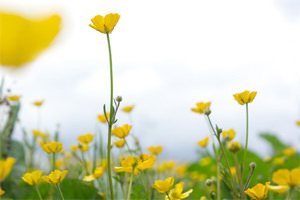
The optimal time for preparing a buttercup is the end of the flowering period, when the fruits are still tied, and the petals have not yet come from all the flowers. At this point, the concentration of nutrients in the aerial parts of plants reaches its apogee. Buttercup roots are rarely used in medicine due to extreme toxicity.
Buttercups are harvested using a garden pruner or large, sharp scissors. You need to carefully cut the stems at a height of 5-10 cm above the ground to get the most juicy part of the plant. Tearing buttercups is not recommended for two reasons: firstly, you soil your hands with poisonous juice, and secondly, damage the root system, and the plant then most likely will die.
By the way, for safety, it is better to collect buttercups in gloves and thick clothes. After contact with the skin, and especially on the mucous membranes, buttercup juice causes severe irritation and burn, up to the formation of ulcers and blisters. Collected raw materials should be thoroughly washed and dried in the attic or under a shed. Naturally, all these manipulations must be performed with gloves.
Buttercup can not be dried in direct sunlight, because most of the active ingredients, including protoanemonin, will completely evaporate from it.
When does a buttercup bloom?
Periods of flowering in plants of this family vary greatly in duration, depending on the species. There are buttercups, which bloom in April, and by June they already have fruits with seeds, and there are some that delight the eye with bright flowers from May to October, such as the marsh buttercup. If you stumbled across a bush of buttercups, and plan to collect raw materials, try using the scientific literature and photos to determine the type and, thus, find out the optimal time for harvesting.
How to store?
A fresh buttercup cannot be stored at all, useful substances quickly evaporate from it, therefore it is necessary to start treatment immediately. But dried raw materials can be packaged in paper bags and hidden in the closet, where the buttercup will retain its medicinal properties for about one year.
Found a mistake in the text? Select it and a few more words, press Ctrl + Enter
The composition and properties of buttercup
The following biologically active substances are present in all types of buttercups:
Protoanemonin is a volatile poisonous alkaloid with a strong characteristic odor and a bitter burning taste. A small amount of protoanemonin has a healing effect on the human body: it tones up, stimulates the nervous system, boosts immunity, kills germs, increases red blood cell levels and hemoglobin in the blood. And in large doses, it is the strongest plant poison with neuroparalytic action, causing death from depression of the respiratory center;
Coumarins - natural anticoagulants, which also accelerate the processes of cell regeneration, act as a source of vitamin P, prevent the growth of tumors and the formation of blood clots;
Cardiac glycosides- substances that normalize cardiac activity, slow down the rhythm of contractions of the heart muscle, increase systole and prolong diastole, activate blood circulation and decrease;
Saponins - work as a choleretic agent, and also reduce temperature and pressure, dilute sputum and accelerate its excretion from the bronchi, tone up and stimulate the reproductive system;
Tannins- narrow and strengthen the walls of blood vessels, create a very thin protective film on the mucous membrane of the digestive tract after ingestion, and on the surface of the skin - when applied externally;
Alkaloids are a group of volatile toxic compounds that, in small doses, stimulate the immune system, tone up, relieve fever, anesthetize, lower blood pressure, strengthen the walls of blood vessels, stop bleeding and disinfect wounds;
Flavonoids are substances that prevent the destruction of valuable hyaluronic acid in the human body, and also stimulate metabolic processes, increase the elasticity of blood vessels, neutralize free radicals and prevent sclerotic damage to the circulatory system;
Vitamin C is one of the most important for the health of vitamins, without which the normal functioning of the endocrine glands and the full absorption of dietary iron is impossible. Ascorbic acid is also an antioxidant, a defender against cancer and an important element for maintaining the nervous system. Vitamin C deficiency has a detrimental effect on immunity and blood formation;
Carotene is a substance necessary for good vision, strong bones and teeth, supple skin and beautiful hair. The lack of carotene in the body turns into early aging, slowing down the synthesis of proteins, development and slowing down the process of cellular regeneration;
Amino acids are the most important substances that affect blood quality, hemoglobin level and the body's ability to purify. The more valuable amino acids a person receives, the faster he gets rid of the harmful components of food and air - pesticides, radionuclides, heavy metals;
Vegetable oils- nourish and rejuvenate tissues, normalize metabolic processes, accelerate cell regeneration, neutralize carcinogens and prevent the appearance of malignant tumors.
Thus, buttercup has many useful properties:
Tones up;
Pain relief;
Reduces temperature and pressure;
Disinfects;
Loosens;
Kills the fungus;
Protects against cancer;
Normalizes metabolic processes;
Buttercup Treatment
Traditional medicine is a buttercup without much interest, although it has been proven that this plant is one of the most effective remedies for skin tuberculosis. At the pharmacy stalls, you will never find dried buttercup, sold on a par with chamomile, so if you want to try the buttercup treatment, you will have to go for the raw materials to the nearest meadow on your own.
Doctors refer to the treatment of poisonous plants with explicable caution and skepticism, but this is not a reason to refuse to consult. Buttercup has serious contraindications, in addition, it is very important to choose the right dosage and type of medicinal raw materials. Different parts of the plant have a different healing effect on intensity, so the advice of an experienced herbalist or naturopathic doctor will definitely not hurt you.
Flowers
Buttercup flower infusions are used primarily to stimulate the nervous system and improve blood quality. This tool also well disinfects and kills the fungus, so buttercup flowers are used to treat scabies, intestinal infections, Staphylococcus aureus and fungal infections of the skin. From such raw materials you can make an excellent insecticide, with the help of which you can easily clean your house from ticks, bedbugs and moths, or protect fruit crops in your garden from pests.
If you grind freshly picked buttercup flowers into a mush, you get an analogue of a mustard plaster and a blister plaster. By applying this remedy to a boil or boil, you will accelerate the maturation and release of pus. Buttercup flowers must be much stronger than usual, and you can keep them on your chest and back for no longer than fifteen minutes. Flowers can rub the aching joints or back, then they will act as a painkiller. And in malaria, as we mentioned above, crushed buttercup flowers are applied to the wrists and elbows to relieve seizures.
Rhizomes and tubers
The concentration of poisonous alkaloids is very high in the root system of the buttercup, so treatment with this part of the plant must be approached very carefully. Powder from fresh tubers or roots is used for removing warts and disinfecting purulent wounds. This raw material is also suitable for the preparation of alcohol tinctures against cancer, but an experienced herbalist who knows the exact dosage and is versed in the toxicity of the roots of various types of buttercups should do such things.
There is an ancient folk method of infertility treatment, according to which the buttercup roots should be cleaned and inserted into the vagina at night in the middle of the cycle in order to stimulate sexual function and ensure successful conception. But it is obvious that this barbaric method of treatment can cause not long-awaited motherhood, but a burn of the mucous membrane of the vagina.
Seeds
Buttercup seed decoction is used for colds as an expectorant and immunity stimulant. In general, little is known about the treatment with buttercup seeds, and the most likely reason for the scarcity of information is that it is difficult to collect them in sufficient quantities, and there is no need to do this when there are flowers, leaves and stems with the same properties.
Leaves and Stems
The grassy part is the most popular type of raw material for treatment with buttercups. It is from fresh and dried leaves and stems that broths and infusions are most often prepared against ulcers and boils, headaches and colds and skin infections. Freshly squeezed buttercup juice copes well with warts, mycoses and scabies.
If you are injured in a joint or soft tissue, hurry to apply crushed buttercup leaves to this place, so you will avoid severe edema and internal hemorrhage, as well as relieve pain. A gruel of leaves and stems of buttercup prevents the formation of an ugly bruise at the site of injury, if you apply it immediately and hold for 15 minutes.
In folk medicine since ancient times a mixture of table vinegar and crushed buttercup leaves has been used. This healing tool helps with, and, if regularly rubbed into the affected skin. But do not forget to wash off the drug in 10-15 minutes.
Infusion, tincture, ointment and buttercup juice

Eastern healers, Russian healers and northern shamans prepare medicines from the buttercup. It is safe to say that this healing has long and thoroughly studied. Buttercup treatment is important for skin inflammations, pain syndrome of various etiologies, neuralgia and joint damage, colds and oncology. The main thing is to choose the right dosage form.
Water infusion
The most frequently used form is water infusion, since making a decoction of buttercup is technically wrong, because most of the biologically active substances evaporate from it when boiling. A maximum of five minutes, you can boil the buttercup, or rather just steam it with boiling water, wrap and insist. The time of infusion should not be too long, it is optimal to keep the raw material in the medicine for 30-60 minutes, and then filter it thoroughly, because over a long period of time too many poisonous alkaloids will pass into it.
We will not give here the recipe for alcohol tincture for the treatment of cancer, because it is a dangerous and complex technique that requires extensive experience and accuracy. But the external use of buttercup tincture is quite safe and useful in many diseases.
Take 50 fresh buttercup flowers, cover with half a liter of medical alcohol, seal the glass container tightly and keep the medicine in a dark, cool place for the 21st day, shaking occasionally. Then filter and use for warming compresses, rubbing and disinfecting wounds.
Therapeutic ointment
To prepare the ointment, take fresh buttercup flowers, pound them and mix them with lard (pork fat) in the ratio of one to four. Buttercup ointment should be stored in the refrigerator in a tightly closed glass jar.
This is an excellent remedy for colds - just rub the chest and back with an ointment from the buttercup and turn into a warm scarf to calm and calmly sleep all night long. It is possible to apply such ointment both on the sore throat, and on the inflamed lymph nodes, and on the drained muscles, but be sure to wrap the sore spot in order to enhance its healing effect.
The juice
Freshly squeezed buttercup juice allows you to remove warts, as well as relieve a painful toothache, if cotton wool dipped in it, briefly applied to the gums. Strongly diluted buttercup juice treats cataracts at an early stage: you need to wipe sore eyes 3-4 times a day.
Fresh buttercup juice is a very caustic substance that, with prolonged contact, causes burns to the skin or mucous membranes, ulceration or even necrosis of the epidermis.
Precautions when treating a buttercup

Do not forget that buttercup is a very poisonous plant, so they can be treated only after consulting a doctor. It is also important to follow the dosage precisely, since a substance that benefits in small quantities can cause irreparable harm in large quantities.
The symptoms of ranunculus poisoning are as follows:
Sharp pain in epigastria;
Loose stools;
Slowdown or surges in the pulse;
Profuse drooling;
If there is a suspicion of poisoning with a buttercup, it is necessary to perform simple actions as soon as possible:
Call an ambulance;
Wash the stomach with a weak solution of potassium permanganate;
Drink activated carbon at the rate of 1 tablet for every 10 kg of weight.
Protoanemonin, a poisonous volatile alkaloid contained in buttercup, causes severe poisoning. The danger is not only getting a large dose of this alkaloid into the body, but also a long-term effect on the skin and mucous membranes. Buttercup extract injections threaten with tissue destruction and necrosis, so they are not currently being made. Only the techniques described above are relevant, and only the dosages mentioned that need to be strictly followed.
Contraindications to the use of buttercup
Buttercup treatment is contraindicated for pregnant and lactating women, as well as for people with individual intolerance to the biologically active ingredients of the plant.
Cattle poisoning with a buttercup
Livestock grazing in the floodplain meadows is exposed to the danger of buttercup poisoning. If an animal eats a lot of poisonous grass, it will lose the ability to chew food, will experience severe anxiety and excruciating pain in the abdomen. Guessing about poisoning is possible by drooling, vomiting and.
In severe cases, the animal begins to convulse half an hour after eating the buttercup, it falls to the ground, the eyes rotate, breathing is interrupted, and then the victim loses consciousness and dies. To save your cattle from such a fate, you need to carefully examine the pasture for the presence of poisonous plants (buttercups) before chasing them to graze.
Recipes for Buttercup Treatments
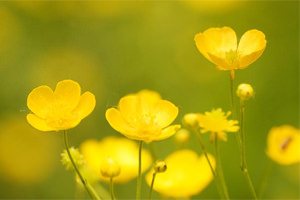
Broth from heel spurs.Pour a glass of fresh grass into a three-liter pot of hot water, boil for a few minutes, cool a little, pour it into a bowl and steam your legs until the broth is completely cool.
Infusion of skin tuberculosis.Pour three tablespoons of crushed buttercup leaves with two cups of boiling water and leave for three hours, then strain and make lotions and compresses using cotton wool and warm infusion.
Tincture with umbilical hernia.Half a cup of buttercup flowers, pour half a liter of vodka and leave for a dark, cool place for three days, then strain and take one tablespoon of food before meals three times a day for a month.
Tincture of rheumatism and gout.For half a glass of vodka you will need 10 grams of fresh buttercup flowers. The tincture should be kept in a dark place for a month, and then filtered and used for rubbing and compresses.
Broth from hepatitis and liver failure.Pair a teaspoon of freshly chopped stalks and buttercup leaves with a glass of steep Kiptyak, soak for 15 minutes in a water bath, then strain carefully and take one and a half teaspoons three times a day before meals for at least two months to achieve a lasting therapeutic effect.
Acetic tincture from pancreatitis.Mix in a glass jar a glass of fresh herb buttercup and two and a half glasses of table vinegar (9%). Incubate the tincture for a day, then strain thoroughly and dilute with water at a ratio of 1:10. With each attack of pain, take the medicine, starting with one drop and increasing the dosage twice every half hour, until you reach thirty-two drops. To resort to such treatment is possible only after consulting a doctor.
Author of the article: Sokolova Nina Vladimirovna, naturopathic doctor, phytotherapeutist

